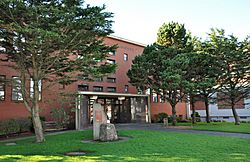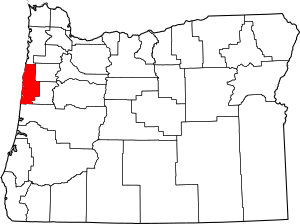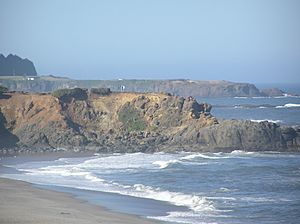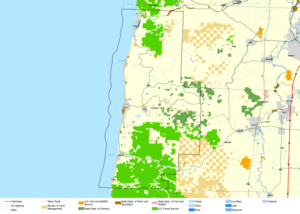Lincoln County, Oregon facts for kids
Quick facts for kids
Lincoln County
|
||
|---|---|---|

Lincoln County Courthouse in Newport
|
||
|
||

Location within the U.S. state of Oregon
|
||
 Oregon's location within the U.S. |
||
| Country | ||
| State | ||
| Founded | February 20, 1893 | |
| Named for | Abraham Lincoln | |
| Seat | Newport | |
| Largest city | Newport | |
| Area | ||
| • Total | 1,194 sq mi (3,090 km2) | |
| • Land | 980 sq mi (2,500 km2) | |
| • Water | 214 sq mi (550 km2) 18%% | |
| Population
(2020)
|
||
| • Total | 50,395 | |
| • Estimate
(2023)
|
50,821 |
|
| • Density | 47/sq mi (18/km2) | |
| Time zone | UTC−8 (Pacific) | |
| • Summer (DST) | UTC−7 (PDT) | |
| Congressional district | 4th | |
Lincoln County is one of the 36 counties in the U.S. state of Oregon. It is located on the beautiful Oregon coast. As of 2020, about 50,395 people live here. The main city and county seat is Newport. The county is named after Abraham Lincoln, who was the 16th president of the United States.
Lincoln County is part of the Newport Micropolitan Statistical Area. This means it's an important area for jobs and services, centered around the city of Newport.
Contents
History of Lincoln County
Lincoln County was officially created on February 20, 1893. It was formed from parts of Benton and Polk counties. Over the years, its borders were adjusted a few times.
Choosing the County Seat
When the county was first formed, Toledo was chosen as the temporary county seat. This means it was the main town where the county government was located. In 1896, Toledo became the permanent county seat.
However, people later voted three times to decide if the county seat should move to Newport. The first two votes, in 1928 and 1938, failed. But in 1954, the vote finally went in Newport's favor. So, Newport became the new county seat. Even though Toledo is still an important industrial center, it never got back its role as the county's main government town.
Connecting the County
For many years, Lincoln County was quite isolated from the rest of Oregon. This changed with the building of major roads. U.S. Route 101, which runs along the coast, was finished in 1925. The Salmon River Highway was completed in 1930.
During the Great Depression in 1936, new bridges were built across the bays at Waldport, Newport, and Siletz. Before these bridges, people had to use ferries to cross the water. The bridges made travel much easier and faster.
The Siletz Reservation
The northern part of Lincoln County is home to the Siletz Reservation. This land was set aside for the Siletz people by a treaty in 1855. For a period between 1895 and 1925, non-Native American settlers were allowed to move onto parts of the reservation.
In 1954, the federal government ended the official tribal status of the Siletz people. But in 1977, the Siletz became the first Oregon tribe to have their tribal status given back. Today, their reservation covers about 3,666 acres (14.8 square kilometers).
Economy and Jobs
The main ways people make a living in Lincoln County are through travel and tourism, trade, health services, and construction. Fishing and making paper are also important, but they provide fewer jobs than they used to.
Newport is one of Oregon's two biggest fishing ports. It's even ranked among the top twenty fishing ports in the entire U.S.! Between 1997 and 2000, Newport's port handled an average of 105 million pounds (about 47,600 metric tons) of fish each year.
Newport is also home to Oregon State University's Hatfield Marine Science Center. This is a research center where scientists study the ocean. The Oregon Coast Aquarium is also in Newport, which is a popular place for visitors to see marine animals.
Many other towns in Lincoln County rely on tourism for most of their income. People love to visit the beautiful coast, beaches, and attractions. In 2007, about 18,820 people in the county had non-farm jobs.
Geography of Lincoln County
Lincoln County covers a total area of about 1,194 square miles (3,092 square kilometers). Most of this, about 980 square miles (2,538 square kilometers), is land. The remaining 214 square miles (554 square kilometers), or 18%, is water.
Neighboring Counties
Lincoln County shares its borders with several other counties:
- Tillamook County to the north
- Polk County to the east
- Benton County to the east
- Lane County to the south
Protected Natural Areas
Several important natural areas are located partly or entirely within Lincoln County:
- Oregon Islands National Wildlife Refuge (part of it)
- Siletz Bay National Wildlife Refuge
- Siuslaw National Forest (part of it)
Population and People
| Historical population | |||
|---|---|---|---|
| Census | Pop. | %± | |
| 1900 | 3,575 | — | |
| 1910 | 5,587 | 56.3% | |
| 1920 | 6,084 | 8.9% | |
| 1930 | 9,903 | 62.8% | |
| 1940 | 14,549 | 46.9% | |
| 1950 | 21,308 | 46.5% | |
| 1960 | 24,635 | 15.6% | |
| 1970 | 25,755 | 4.5% | |
| 1980 | 35,264 | 36.9% | |
| 1990 | 38,889 | 10.3% | |
| 2000 | 44,479 | 14.4% | |
| 2010 | 46,034 | 3.5% | |
| 2020 | 50,395 | 9.5% | |
| 2023 (est.) | 50,821 | 10.4% | |
| U.S. Decennial Census 1790–1960 1900–1990 1990–2000 2010–2020 |
|||
What the 2020 Census Shows
In 2020, the census counted 50,395 people living in Lincoln County. There were 22,093 households. The county had about 51 people per square mile. Most people (89.1%) identified as white. About 4.1% identified as American Indian, and 10.0% were of Hispanic or Latino background.
The average household had about 2.23 people. Most people (84.5%) had lived in the same home for at least a year. About 7.2% of people spoke a language other than English at home. The population was slightly more female (51.5%) than male (48.5%).
The average income for a household was $54,961 per year. About 15.2% of the county's population lived below the poverty line.
Cities and Towns

Lincoln County has several cities and many smaller communities.
Cities in Lincoln County
Census-Designated Places (CDPs)
These are areas that are like towns but are not officially incorporated as cities:
- Bayshore
- Lincoln Beach
- Neotsu
- Rose Lodge
- San Marine
Smaller Communities (Unincorporated)
These are even smaller places that are not part of any city or CDP:
Images for kids
See also
 In Spanish: Condado de Lincoln (Oregón) para niños
In Spanish: Condado de Lincoln (Oregón) para niños




